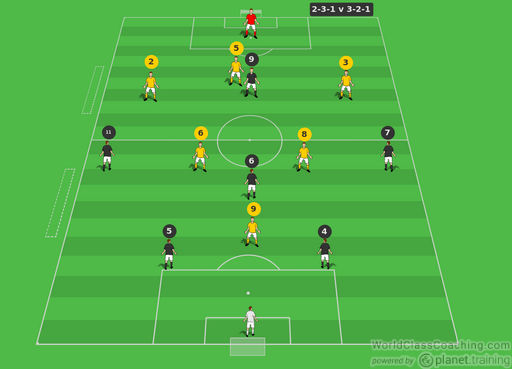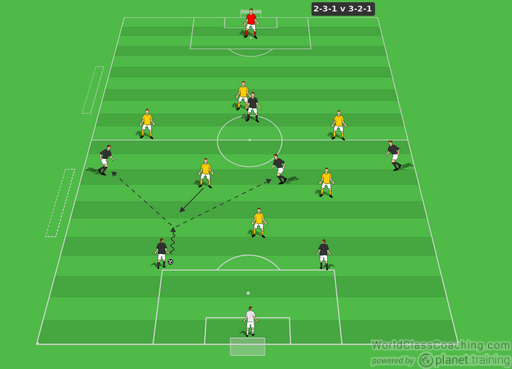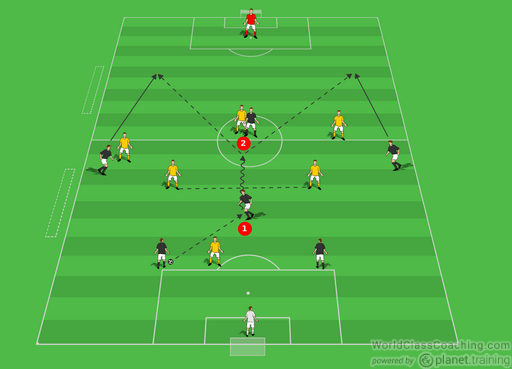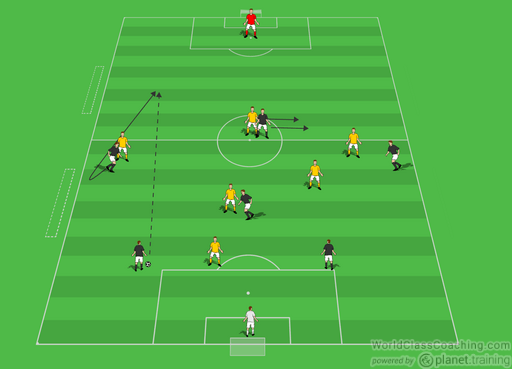By Sean Pearson
With the new USSF mandated birth year and small sided games changes there is a lot of trial and error regarding formations and systems of play. Instead of 8v8 formations, as coaches, we are now trying to figure out how to position our players in the new 7 v 7 and 9 v 9 formations. Some clubs have an academy structure where all teams must play the same formation, others allow coaches to choose what works for their team because players in each team have different attributes.
In these Systems of Play articles, I aim to address a wide range of 7 v 7, 9 v 9 and 11 v 11 formations and ways in which to use your players to your advantage.
Formation
Some coaches are hesitant to play with only 2 defenders in the back, which I can understand 3 offers more stability. I started my coaching career watching coaches play with only 2 in the back so I am used to it. What I think it offers is more options further forward, especially now with a player less on the field. Therefore, in this article I will look at how useful having more attacking players is against a more defensive 3-2-1 system.

Penetration in the 2-3-1
When playing out the back especially against a narrow attacking formation allows the 2-3-1 more width. The wide players and the central midfielder look to get into gaps between the players of the 3-2-1. Secondly, they need to be behind the line of the players. If they are not there is no penetration. A lot of young players, until coached not too, want to get closer to the ball and not further away. To them they think I want the ball so I must get closer to it, it makes sense to them. So as their coach you must make them aware of what their goal is (penetration) and to be in a position to accomplish this.
As the enter back comes forward with the ball and the midfielder engages, this is the time to pass to either the wide or central midfielder to penetrate their lines.

Another way to penetrate a team’s lines is to run with the ball through it. If, by playing out wide consistently, the opposition central midfielders begin to ‘cheat’ and drift wider to counteract this the central midfielder should look for a big gap between them. If they see this, give them the confidence and instruction to drive with the ball through the gap and penetrate the line.
If successful, the wide midfielders can make runs behind the full backs of the 3-2-1 and the central midfielder aims to pass through those gaps. This type of pass needs a lot of coaching in your practices. Young players who play 7v7 need to be coached why and how to pass into the space. A lot with pass either to your or opposition player’s feet. If successful, you will be able to create a chance on goal within 2 passes.
I understand with youth development coaches are fixated with possession. But let’s be real for a minute how many passes until a mistake (technical execution, bad decision etc.) do you expect your team to really accomplish in consecutive order. Teaching possession is absolutely needed to produce players but so is penetration, penetration is how you score goals, which is the best thing for any player to achieve in soccer.

So, let’s say players on the 3-2-1 are now stopping passes to the central and wide midfielders by man marking. What do you do? You can actually use this against them. What you mustn’t do is compact that side of the field, you need to do the opposite and spread it out instead. Inform your striker to move to the opposite side of the field and your central midfielder to move further away from the ball. This leaves the wide player 1v1 with the full back.
Using the man marking against them your wide midfielder can drop down, forcing the full back to follow them. Both your defender and wide midfielder know where the ball is going but the full back is thinking feet. The wide midfielder spins and at this point the defender plays a strong pass into the space behind both players. The striker has moved away therefore clearing the space for this pass to happen. The pass again must be coached to have the right weight, too slow it is easy intercepted, too fast and the GK can come forward to claim it.

I understand that these concepts for younger players are difficult but it’s what development is, challenging players, you don’t want everything to be easy for them, they don’t. I personally don’t agree with everyone gets a participation trophy, I like players to be challenged so they can feel accomplishment and a sense of pride. Enthusiastically praise them for the thought process behind their decision to attempt the penetration. Don’t kill their spirit for bad execution, calmly explain what they need to do the next time, sometimes don’t say anything, its ok to let them fail, they need to learn to pick themselves up, fail again until they get it right. They will feel a lot more pride and success this way.
By Sean Pearson. Sean is also the author Coaching Team Shape in the 3-3-1, Coaching Team Shape in the 4-2-3-1 and Coaching Team Shape in the 4-3-3


